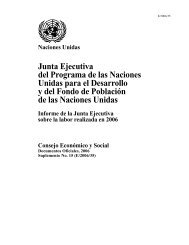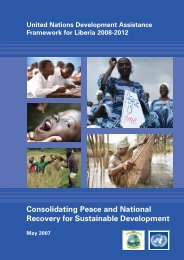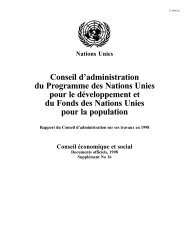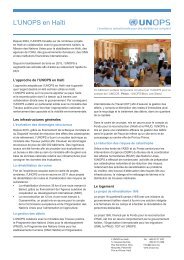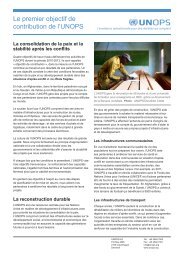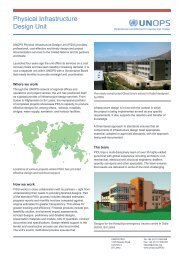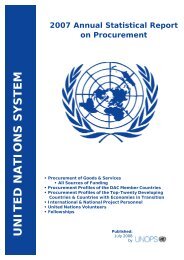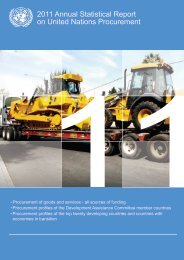India UNDAF 2008-2012 - UNOPS
India UNDAF 2008-2012 - UNOPS
India UNDAF 2008-2012 - UNOPS
Create successful ePaper yourself
Turn your PDF publications into a flip-book with our unique Google optimized e-Paper software.
<strong>India</strong> <strong>UNDAF</strong> <strong>2008</strong>-<strong>2012</strong><br />
Accordingly, the <strong>UNDAF</strong> has an explicit focus on women and girls as the critical group<br />
that must be reached in the UN assisted programmes. It recognizes that effective implementation<br />
of even the best designed policies is often hampered by a possible "disconnect"<br />
between national level policies, state-level subjects and local level implementation.<br />
It recognizes the district as a special unit or level of governance that presents<br />
a challenge as well as an opportunity. Further, a subset of the activities of the <strong>UNDAF</strong><br />
will be about convergence of efforts to synergise and holistically address the multisectoral,<br />
inter-disciplinary aspects of development challenges.<br />
The <strong>UNDAF</strong> also factors in the occurrence of sudden disasters and slow environmental<br />
changes which can frustrate and undo development efforts. Since these cannot be<br />
wished away, adequate contingency planning and risk management will be an integral<br />
part of the UN's development agenda.<br />
<strong>UNDAF</strong> Outcome One aims to support the Government to achieve a strengthened<br />
policy framework and implementation capacity of large scale state and national programmes<br />
to reduce disparities, for the achievement of 11 th Plan Goals. This outcome<br />
spans the macro (national policy that impacts at all levels), meso (state level policy)<br />
and micro (local) level. It intends to support Government in addressing the "disconnect"<br />
between national, state and local level, and to provide support and access to<br />
national and global experience to bring about coherence between these levels, so as to<br />
achieve smooth programme implementation with the larger purpose of attaining the<br />
11 th Plan goals and targets that relate to the MDGs. <strong>UNDAF</strong> outcome one is also about<br />
better targeting so as to reach out to the "unreached". This outcome includes experimenting<br />
with innovative models and pilots to demonstrate effective ways of improved<br />
programme implementation.<br />
<strong>UNDAF</strong> Outcome Two focuses at the district level - where the locally elected representation,<br />
public administration, law enforcement and development functions converge.<br />
It is the level of service delivery at which the system interfaces directly with the<br />
citizens. Decentralisation, particularly as the devolution of funds, functions and functionaries<br />
increasingly occurs, makes additional demands on the district governance<br />
system, well beyond its traditional role. Partnerships with a range of civil society players<br />
including Community Based Organisations and the private sector are increasingly<br />
important. Apart from the need for efficiency, responsiveness, accountability and transparency,<br />
the district is also the point where inclusiveness becomes particularly critical,<br />
to ensure that resources are allocated equitably and marginalized groups are able<br />
to access services. This <strong>UNDAF</strong> outcome aims essentially to develop the capacities of<br />
all governance actors at the district level and below to determine the local development<br />
priorities and ensure efficient and equitable delivery of public services through<br />
11




